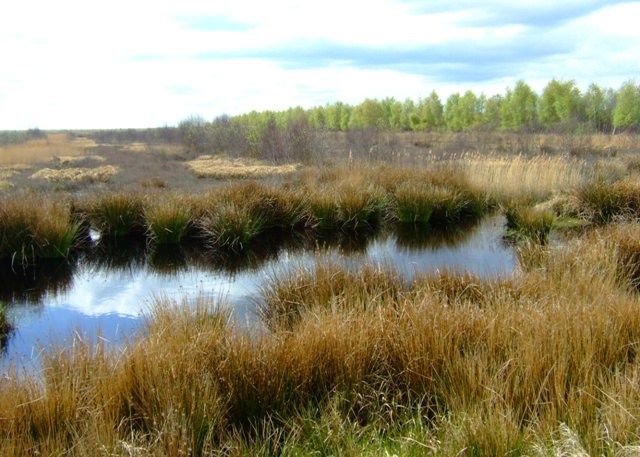Draining Peatlands Gives Global Rise to Greenhouse Laughing-gas Missions
Published on by Water Network Research, Official research team of The Water Network in Academic
Drained fertile peatlands around the globe are hotspots for the atmospheric emission of laughing-gas - a powerful greenhouse gas called nitrous oxide, which is partly responsible for global warming and destruction of the ozone layer, a new study shows.

Representative image, Source: Wikimedia Commons, Labeled for Reuse
Research into natural peatlands such as fens, swamps and bogs, as well as drained peatlands, found that either draining wet soils or irrigating well-drained soils boosts the emission of nitrous oxide significantly.
Led by researchers at the University of Tartu, Estonia and the University of Birmingham and the University of Tartu, Estonia, the study took in 58 peatland sites around the world. These included locations in the United States, Australia, Brazil, South America, Australia, New Zealand, East Africa, Southeast Asia, Siberia and Europe.
The authors of the study -- published in Nature Communications -- are calling for increased conservation of fens and swamps to help reduce the impact of climate change and protect the ozone layer.
Dr Sami UllahProf UÜlo Mander, Senior Lecturer in Biogeochemistry, at the University of BirminghamTartu, who conceived this research with a global network of 36 scientists said: "Nitrous oxide is no laughing matter -- it is a significant contributor to global climate change and depletion of the ozone layer, which protects our planet from cosmic radiation.
"Organic soils, such as fens, swamps, bogs and drained peatlands, make up more than one-tenth of the world's soil nitrogen pool and are a significant global source of laughing gas. They are significant sources of nitrous oxide when drained for cultivation."
Dr Sami Ullah, Senior Lecturer in Biogeochemistry at the University of Birmingham added that this potential problem was further exacerbated when drained cultivated organic soils are irrigated, particularly in warm/tropical regions, which significantly increases nitrous oxide emission.
The report's lead author Dr. Jaan Paan Pärn is an exchange postdoctoral fellow at the University of Birmingham working under with Dr. Ullah and 's supervision Prof. Mander.
"Our findings show that artificial drainage will be the primary driver of future changes in laughing gas emission from organic soils," he explained. "This effect will be more pronounced in tropical regions leading to more nitrous oxide emitted to the atmosphere.
"Therefore, conservation and restoration of tropical fens and swamp forests should be made a priority to avoid and reduce emissions of this grim laughing gas."
Dr. Jaan Parn Pärn added that predicting soil response to changes in climate or land use was central to understanding and managing nitrous oxide emission.
Previous studies have suggested multiple factors of nitrous oxide emission without a clear global pattern for the prediction of nitrous oxide emission from organic soils. A work group of 37 experts from 24 research institutions conducted a global field survey of nitrous oxide emissions and potential driving factors across a wide range of organic soils in 58 sites around the world.
The survey found that changes in nitrous oxide levels fluxemission can be predicted by models incorporating soil nitrate concentration, water content and temperature. Nitrous oxide emissions increase with nitrate and follow a bell-shaped distribution peaking at intermediate soil moisture content around 50%. Both nNitrate and soil moisture together explains 72% of laughing gas emission from the global organic soils.
Story Source: University of Birmingham
Journal Reference :
- Jaan Pärn, Jos T. A. Verhoeven, Klaus Butterbach-Bahl, Nancy B. Dise, Sami Ullah, Anto Aasa, Sergey Egorov, Mikk Espenberg, Järvi Järveoja, Jyrki Jauhiainen, Kuno Kasak, Leif Klemedtsson, Ain Kull, Fatima Laggoun-Défarge, Elena D. Lapshina, Annalea Lohila, Krista Lõhmus, Martin Maddison, William J. Mitsch, Christoph Müller, Ülo Niinemets, Bruce Osborne, Taavi Pae, Jüri-Ott Salm, Fotis Sgouridis, Kristina Sohar, Kaido Soosaar, Kathryn Storey, Alar Teemusk, Moses M. Tenywa, Julien Tournebize, Jaak Truu, Gert Veber, Jorge A. Villa, Seint Sann Zaw, Ülo Mander. Nitrogen-rich organic soils under warm well-drained conditions are global nitrous oxide emission hotspots . Nature Communications , 2018; 9 (1) DOI: 10.1038/s41467-018-03540-1
Media
Taxonomy
- Watershed Management
- Environment
- Watershed
- Wetlands
- EU environmental policy
- Wetlands